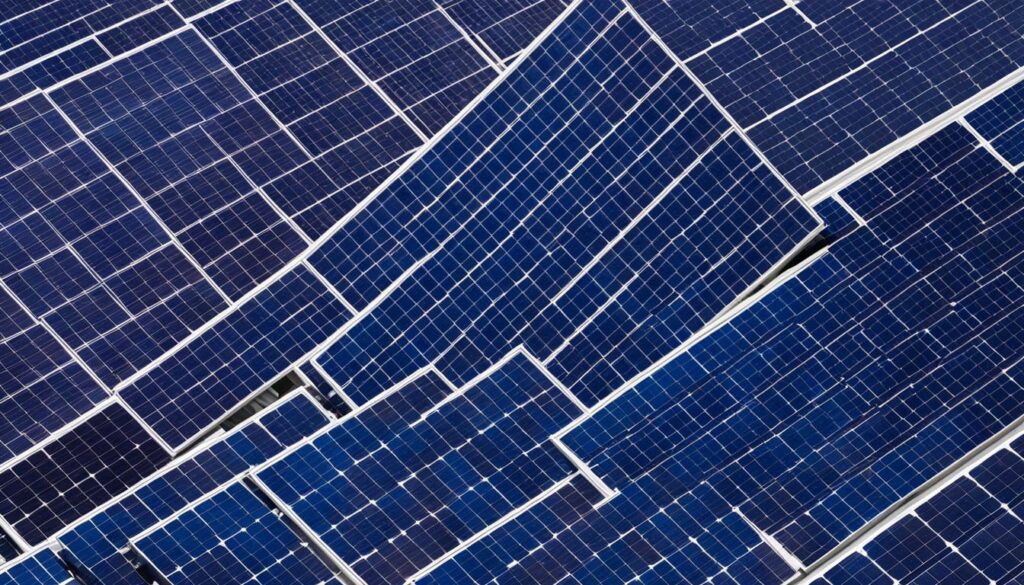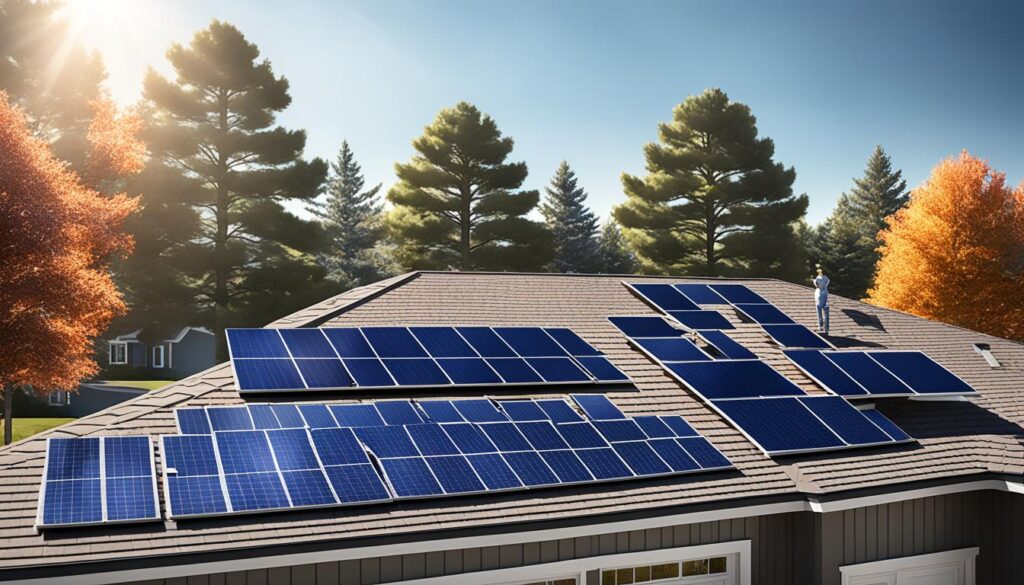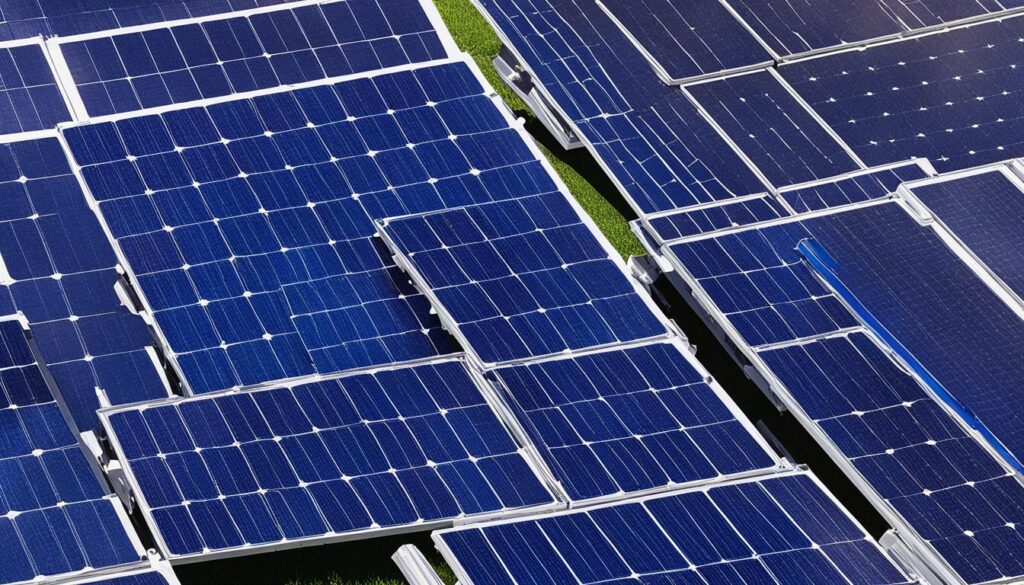When choosing solar panels for your PV system, you’ll meet monocrystalline and polycrystalline types. Both work with solar energy but vary in key ways. Monocrystalline solar panels feature dark solar cells of pure silicon. They’re very efficient, but cost more. On the other hand, polycrystalline solar panels have light blue cells. These come from multiple silicon crystals and are efficient, albeit less so than monocrystalline panels. They’re the budget-friendly choice.
No matter the type, homeowners can get a solar tax credit. This credit supports you in solar panel investments. Both types of solar panels turn sunlight into power, so they function similarly.
Key Takeaways
- Monocrystalline solar panels have higher efficiency but higher cost, while polycrystalline panels are more affordable but less efficient.
- Monocrystalline panels have a solid black appearance, while polycrystalline panels have a distinctive blue hue.
- Both types of solar panels have long lifespans, but monocrystalline panels may last up to 40 years.
- Monocrystalline panels perform better in hot climates due to their lower temperature coefficient.
- The choice between mono and poly solar panels depends on factors like available roof space, budget, and local climate conditions.
Understanding Monocrystalline and Polycrystalline Solar Panels
In the solar energy market, you’ll find two main types of solar panels. These are monocrystalline and polycrystalline solar panels. They both use the same material, silicon, as the base. However, they differ in how the silicon cells are structured.
Monocrystalline Solar Panels
Monocrystalline solar panels come from a single, high-purity silicon crystal. This crystal gets cut into thin, round wafers. Because they come from one crystal, these panels let electrons move more easily. This makes the panel more efficient. They look smooth and black.
Polycrystalline Solar Panels
Polycrystalline solar panels, on the other hand, are made from many pieces of silicon melted together. This process is simpler and cheaper than making monocrystalline panels. But because they aren’t from one crystal, they are a bit less efficient. They look blue.
Silicon Crystalline Structure
The difference between monocrystalline and polycrystalline panels is in their silicon cells. Monocrystalline panels have cells from one continuous crystal. Polycrystalline panels have cells from many fused silicon pieces. This difference affects how well the panels work, their cost, and how they look.
Key Differences: Monocrystalline vs Polycrystalline Solar Panel
When looking at monocrystalline and polycrystalline solar panels, we see a few main differences. These include cost and affordability, efficiency and power output, appearance and aesthetics, lifespan and durability, and temperature coefficient.
Cost and Affordability
Monocrystalline panels cost more because of their manufacturing process. This process creates single crystal cells. But, they are more efficient and powerful than polycrystalline panels. Monocrystalline can hit over 23% efficiency, while polycrystalline tops out under 20%.
Efficiency and Power Output
Monocrystalline panels have a single crystal structure. This allows for better electron movement. So, they’re more efficient and powerful than polycrystalline. This could mean needing fewer panels if roof space is limited.
Appearance and Aesthetics
Monocrystalline panels are solid black, giving them a sleek look. Polycrystalline panels have a blue hue. Many like the clean, modern feel of monocrystalline’s uniform color.
Lifespan and Durability
Both types last over 25 years, but monocrystalline might last longer. Some might even last 40 years. This shows they have an edge in durability and longevity.
Temperature Coefficient
The temperature coefficient is important too. Monocrystalline panels are less affected by high temperatures. They do better in hot climates. This makes them a good choice for very hot areas.

Factors to Consider When Choosing Between Mono and Poly Solar Panels
When choosing between monocrystalline and polycrystalline solar panels, think about a few key things. The first is available roof space. Monocrystalline panels are more efficient, so you need fewer of them in small spaces. Next, your budget and financing options matter. Even though monocrystalline panels are more expensive initially, they offer better long-term performance.
Available Roof Space
Available roof space is crucial in the decision between these panels. Monocrystalline options are more efficient. This means you don’t need as many to produce the same power. They are the best pick for people with little space on their roofs.
Budget and Financing Options
Your solar panel budget and solar financing options are crucial, too. Monocrystalline panels cost more at first. But, they perform better over time, which can save you money. If your budget allows, choosing monocrystalline might be worth the extra cost. On a tighter budget, polycrystalline might be a better choice.
Climate and Temperature Conditions
The place’s climate and temperature also make a difference in your choice. Monocrystalline panels do better in high temperatures. So, if you live in a hot, sunny area, they might be the right choice. This is especially so if you have the space and can afford them.

Conclusion
Monocrystalline and polycrystalline solar panels change sunlight into power. This power is used in homes and businesses. The type of silicon in each panel affects how well it works.
Monocrystalline solar panels are very efficient. They work well even when it’s very hot. But they can be more expensive. On the other hand, polycrystalline panels cost less. But they are not as efficient and don’t handle heat as well.
The best choice depends on the situation. Think about how much space you have on your roof, your budget, and the climate where you live.
Knowing these differences allows people in India to choose wisely. Choosing between solar panel types and monocrystalline vs. polycrystalline considerations is key. It helps get the most out of a solar system, both in performance and cost.
FAQ
What is the difference between monocrystalline and polycrystalline solar panels?
Monocrystalline solar panels use a single silicon crystal. In contrast, polycrystalline panels use many silicon fragments fused together. This difference affects their efficiency, cost, and how they look.
Which type of solar panel is more efficient?
Monocrystalline solar panels are more efficient. They often work better than polycrystalline panels, reaching over 23% efficiency. Polycrystalline panels, however, usually have less efficiency, topping out at under 20%.
Are monocrystalline solar panels more expensive than polycrystalline?
Yes, monocrystalline solar panels do cost more. This higher price is due to the complex way they’re made, with single silicon crystals.
How do the appearances of mono and poly solar panels differ?
Monocrystalline solar panels look solid black. In comparison, polycrystalline panels have a telltale blue tint, reflecting their different internal structures.
Which type of solar panel has a longer lifespan?
Both types have long lives, over 25 years. However, monocrystalline panels might last up to 40 years, offering a potential longevity advantage.
How do the temperature coefficients differ between mono and poly solar panels?
Monocrystalline panels have lower temperature coefficients. This means they handle high heat better, which is great in hot climates. They beat polycrystalline panels in this area.
What factors should I consider when choosing between monocrystalline and polycrystalline solar panels?
Think about roof space, your budget, and location’s climate and temperature. Monocrystalline panels work well for those with limited space, warm weather, and more flexible financial plans. Their higher efficiency can be advantageous in these situations.

